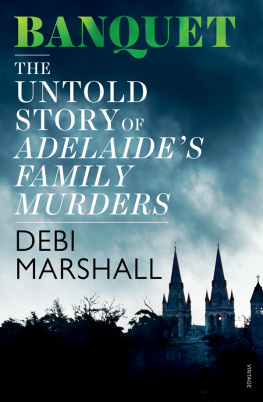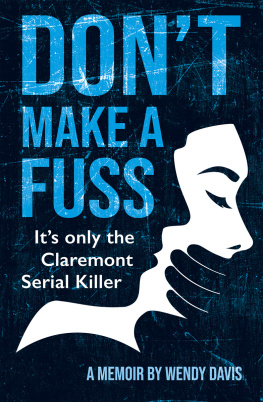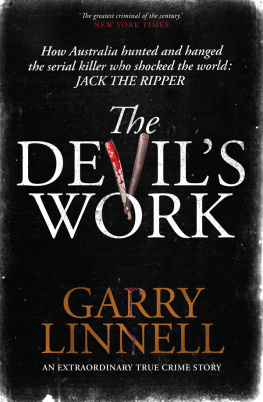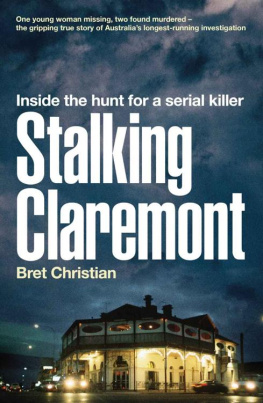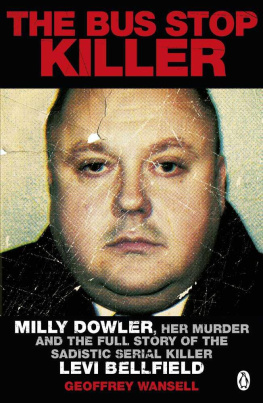Debi Marshall is a freelance journalist and author based in Tasmania. She started her career in 1986 at a newspaper and now writes extensively for national magazines, specialising in crime. She is also an experienced radio and television reporter. A qualified teacher (BA, Dip Ed), Debi also teaches Media and English at college and university.
Also by Debi Marshall
Her Father's Daughter: The Bonnie Henderson Story
Lang Hancock
Justice in Jeopardy: The Unsolved Murder of
Baby Deidre Kennedy
Killing for Pleasure: The Definitive Story of the Snowtown
Serial Murders
All rights reserved. No part of this book may be reproduced or transmitted by any person or entity, including internet search engines or retailers, in any form or by any means, electronic or mechanical, including printing, photocopying (except under the statutory exceptions provisions of the Australian Copyright Act 1968), recording, scanning or by any information storage and retrieval system without the prior written permission of Random House Australia. Any unauthorised distribution or use of this text may be a direct infringement of the author's and publisher's rights and those responsible may be liable in law accordingly.
The Devil's Garden: The Claremont Serial Killings
ePub ISBN 9781864714425
Kindle ISBN 9781864716825
Original Print Edition
Random House Australia Pty Ltd
Level 3, 100 Pacific Highway, North Sydney NSW 2060
www.randomhouse.com.au
First published by Random House Australia 2007
Copyright Debi Marshall 2007
This electronic book is sold subject to the condition that it shall not by way of trade or otherwise, be lent, resold, hired out, or otherwise circulated without the publisher's prior consent in any form other than that in which it is published and without a similar condition including this condition being imposed on the subsequent purchaser
National Library of Australia
Cataloguing-in-Publication Entry
Marshall, Debi.
The Devil's garden: the Claremont serial killings.
ISBN: 9781741664669
1. Serial murders Western Australia Claremont. 2. Serial murderers Western Australia Claremont. I. Title.
364.1523099411
Cover photo reproduced courtesy The West Australian
Cover design by Darian Causby/www.highway51.com.au
Typeset in Minion by Midland Typesetters, Australia
Printed and bound by Griffin Press, South Australia
To my precious daughter, Louise, and lovely mother, Monica
In memory of the girls who didn't come home:
Sarah, Jane and Ciara
I will show you fear in a handful of dust.
T.S. Eliot, 'The Waste Land'
Preface
February 2006. After five years of research and writing, my two true-crime books, Killing for Pleasure: The definitive story of the Snowtown serial killings the macabre, terrible story of South Australia's 'bodies in the barrels' murders and Justice in Jeopardy: The unsolved murder of baby Deidre Kennedy, were published. I felt drenched in blood, exhausted. But another story was tugging at me, one that had been making the news on and off for a decade. Perth's Claremont serial killings: the longest, most expensive and most secretive unsolved murder investigation in Australian history. Between 1996 and 1997, three girls went missing; only two bodies were ever found. A decade on, and still no one has been charged. But I sensed there was more to this story. Much more. As my research was to prove, I was right.
Just how many victims has this serial killer claimed? Police have admitted that Julie Cutler, who disappeared in 1988, could well have been the first victim. Sarah Spiers went missing in summer. Jane Rimmer in winter. Ciara Glennon in autumn. Coincidence, probably. Or was the killer, in his perverse way, working to nature's pattern? Whatever the truth, this laidback city and particularly its affluent heart, Claremont was, as one journalist described it, being 'king-hit by a menace it couldn't see'.
With police refusing to release modus operandi, the public would have to be content with the findings of the final independent review, in 2004. But there is a catch. Beyond gener-alisations, the details of those reviews cannot be released. The public is again kept in the dark and victims' families continue to wait for answers. At least a few innocent men have their reputations in tatters. And the investigation remains secretive, police and killer locked in what one newspaper calls a 'deadly stalemate'.
Not since the Ivan Milat backpacker serial killing investigations, where police had abundant crime-scene evidence, have police been so under the pump to solve a case. But it is not easy. Homicide investigation by its very nature is challenging, complex, sensitive and political. And serial killers cunning, clever chameleons are, by their very nature, notoriously difficult to apprehend. The length of time the girls were missing ensured deterioration of evidence if there was any. There were no eyewitnesses to the abductions or murders. No definite abduction point. No known crime scene. No murder weapon. No known motive. No confession. And no victim to verbalise what happened. In this atmosphere, a hothouse of pressure from inside and outside the police force, the investigation becomes a battle of wills and power play.
When I started writing this book, the murders had been unsolved for ten years. Why so long? Has the killer simply stopped for fear of apprehension? Died? Or is he or they still operational in another area, another state or another country? As the years slipped by without a resolution Dave Caporn, the former head of the Macro taskforce, formed after Jane Rimmer went missing, admitted that as more time passed, the tougher it would be to secure a conviction. This would prove to be unerringly accurate. This, in Western Australia, a state which averages 34 to 40 murders a year and where police boast a 95 per cent 'solved' rate.
The Claremont serial killings have become a story that has seared itself into the Western Australian psyche; a bleak chapter in Perth's history and one steeped in scuttlebutt and urban myths. It is a case that has damaged some reputations beyond redemption and on which some investigators have staked their careers.
In writing The Devil's Garden, I drew on my 20-year experience as a journalist, biographer and true-crime author, in particular the extensive research and writing I have done about murder and serial killers. I also drew on the findings of experts in this field. From the outset, I kept an open mind on known suspects. Frustratingly, for legal reasons some of the information I gathered from both inside the Macro taskforce sources and outside cannot be included.
Despite plainly setting out a list of questions for police and meeting them in Perth for the first time in February 2006, they refused to speak to me for eight months on the grounds that the Claremont killings are an 'ongoing investigation'. Confronted with the so-called 'blue wall of silence' and not having been made privy to the reasons why it was impossible for me to check their version of events or to apply the balance they expected to receive. At times though thankfully by no means always their attitude to me bordered on outright hostility; at other times I felt patronised by a pervading male culture, the boys club. At all times when they were confronted with questions they did not wish to answer, they could and frequently did take refuge in the line that Claremont was an 'ongoing investigation'. There were a few occasions when I had cause to heed the warnings of journalist colleagues from the eastern states that Western Australia was indeed still the 'Wild West'.
Six weeks before the book's deadline, after negotiation with the police commissioner's media adviser, former journalist Neil Poh, the police agreed, with restrictions, to talk. Better to do it now, they reasoned, than to wait until publication and then have to defend themselves, if necessary.


